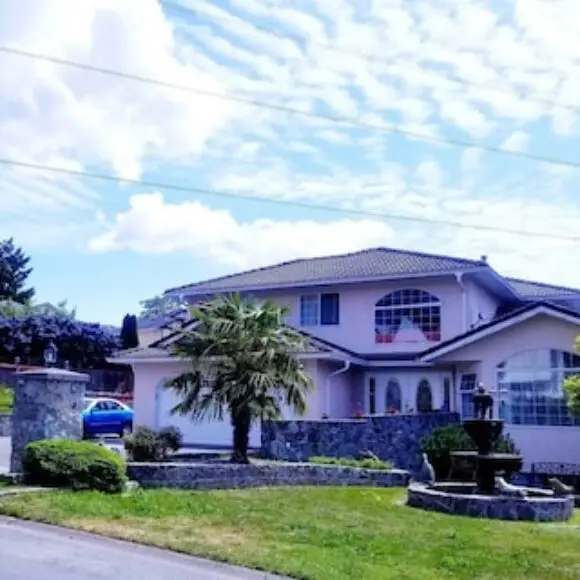Hotel Estuary House Reflexology B&B

Estuary House Reflexology B&B
Hotel Estuary House Reflexology B&B reviews
Looking for a great place to stay in Comox? Book Estuary House Reflexology B&B; rated and is available from CAD $ 131. Estuary House Reflexology B&B is conveniently located near ferry terminals, and can be booked directly with Trivago.
📍 Address Estuary House Reflexology B&B
2810 COMOX ROAD, V9N 3P6, Comox, Canada
FAQ
How can I find the latest fare information for the ferry Vancouver sailing from Mayne Island (Village Bay) to Swartz Bay?
To find the latest fare information for the Vancouver Ferry sailing from Mayne Island (Village Bay) to Swartz Bay, it is best to check the Mayne Island to Swartz Bay fares page. Fares can vary depending on the time of year and the type of vehicle. This page offers up-to-date pricing details, ensuring you have the most accurate information before your trip.
What parking options are available at the Duke Point ferry Vancouver terminal?
The Duke Point ferry Vancouver terminal offers various parking options for travelers. Whether you’re planning a short trip or an extended stay, you’ll find suitable parking solutions. For detailed information regarding parking availability and fees, it is recommended to review the Duke Point terminal parking information. Parking at the terminal is a pay parking system, and during busy periods, parking spots can fill up quickly, so it is best to arrive with time to spare.
How much does it cost to take a vehicle on the Horseshoe Bay to Departure Bay ferry Vancouver crossing?
The cost of taking a vehicle on the Horseshoe Bay to Departure Bay ferry Vancouver crossing is determined by several factors, including the size and type of your vehicle, as well as the time of year. To get precise pricing, it’s best to check the Horseshoe Bay to Departure Bay vehicle fares. Fares typically include a base rate for the vehicle and additional charges for each passenger. During peak season, especially summer months and holiday periods, fares may be higher. It’s also worth noting that fuel surcharges can be added to the total cost.
Ferry Vancouver
Vehicle transport options accommodate everything from motorcycles to large RVs and commercial trucks. Different vehicle categories have specific size restrictions and pricing structures. Passengers traveling with vehicles should arrive early for check-in and security screening processes at ferry terminals.
Ferry travel tips for first-time visitors include arriving early, bringing layers for changing weather conditions, and planning ground transportation in advance. Understanding terminal layouts and boarding procedures reduces travel stress. Experienced ferry travelers recommend booking accommodations on Vancouver Island in advance, especially during peak season periods.
Wildlife viewing opportunities during ferry crossings include orcas, seals, dolphins, and diverse seabird species throughout the Salish Sea. The best viewing occurs from outdoor decks, and crew members often announce wildlife sightings over the ship’s public address system. Binoculars enhance the wildlife watching experience during these scenic journeys.
Cultural experiences begin during ferry travel with onboard art displays featuring local Pacific Northwest artists. Indigenous cultural elements appear in vessel names, artwork, and interpretive displays. These features introduce visitors to the rich cultural heritage of Vancouver Island and coastal British Columbia.
Accessibility features ensure all passengers can enjoy ferry travel, with elevators, wheelchair-accessible restrooms, and designated seating areas. Vehicles with accessibility equipment receive priority boarding assistance. Ferry staff provide support for passengers with mobility challenges throughout the journey.
Ferry reservations are highly recommended, especially during peak summer months and holiday periods when demand significantly exceeds capacity. Advance booking ensures guaranteed passage and reduces waiting times at terminals. Walk-on passengers and cyclists typically have more flexibility, while vehicle spaces often sell out during busy travel periods.
Fuel and vehicle services are available at some ferry terminals, allowing travelers to prepare for their Vancouver Island adventure. Terminal locations often feature gas stations, convenience stores, and automotive services. Pre-trip vehicle inspections ensure safe travel on Vancouver Island’s diverse road conditions.
Multi-day Vancouver Island itineraries often begin with ferry travel from the mainland, allowing tourists to explore the island’s diverse regions. Popular destinations include Victoria’s Inner Harbour, Tofino’s surf beaches, and the wine regions of the Cowichan Valley. Ferry connections enable comprehensive island exploration combining urban and wilderness experiences.
Ferry pricing varies by route, season, and vehicle type, with significant differences between passenger fares and vehicle transportation costs. Peak season rates apply during summer months when tourism demand is highest. Multiple pricing tiers accommodate different traveler needs, from foot passengers to large RVs and commercial vehicles.
Tourist information centers at major ferry terminals provide maps, brochures, and local expertise for Vancouver Island travel planning. Knowledgeable staff offer recommendations for accommodations, attractions, and activities. These resources help first-time visitors maximize their Vancouver Island experience.




